The global health crisis has presented many unexpected challenges to teaching and learning at Rice, bringing new perspective to the physical, mental, academic and social needs of students. With the generous support of Rice donors, the university’s faculty and staff have been vigilant as ever in their response to COVID-19. We chatted with some of these campus heroes on Zoom to learn more about what they’re doing to continue providing the best in education and ensuring the health and safety of the Rice community.
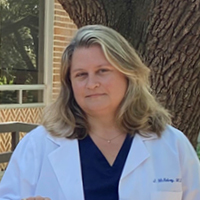 Jessica B. McKelvey M.D. ’93 (Will Rice), Director of Student Health Services
Jessica B. McKelvey M.D. ’93 (Will Rice), Director of Student Health Services
In her role as director of student health services, Dr. Jessica McKelvey is dedicated to ensuring the health of all of Rice’s students. When the spread of COVID-19 threatened to spread beyond the hedges, Dr. McKelvey and her team sprang into action to ensure that students remained safe, whether at Rice or back at home.
- What is Rice Student Health Services doing to maintain the health and safety of Rice’s campus?
-
We were first looking at the situation as, "How are we going to address this as an illness on campus?" We had to completely rethink how we approach patient care overnight. Our staff members are part of the essential staff on campus. We have three physicians, and all three physicians were reviewing CDC recommendations every single morning before we started clinic. Medicine is always a fun career because things change and you get to learn all the time, but we were learning hourly.
We are rotating in teams, so that if one member becomes ill — for whatever reason — this only takes out one team and not the entire staff. We have minimal personal protective equipment (PPE), so we first implemented screening of ill patients to reduce spread of infection, but we then quickly realized the asymptomatic carrier status of COVID-19 patients and redesigned our care.
The State Medical Board relaxed laws on telephone, virtual and video care which allowed us to provide care without putting fellow students or our staff at risk. As students disappeared from campus to destinations around the world, we were still able to provide medical advice. We also quickly ordered supplies for our students when the virus started escalating. We had hundreds of thermometers and acetaminophen distributed to all of the colleges and graduate housing in early March. This enabled quick symptom monitoring and improved virtual visits. We repeated the thermometer distribution for those students remaining on campus during remote learning.
- What extra services are you providing at this time?
-
We are providing virtual visits through telephone and video, including ill visits. We have moved to virtual visits for our study abroad consults. This way, students across the world can still complete their study abroad applications despite lack of access to clinics at this time. We are also providing supply pick-ups. Many of our students need supplies for illnesses — acetaminophen, cough drops, pulse oximeters and more. These items are difficult to find presently, and we stocked up early on in order to provide free supplies for self-care. We are checking on these students daily.
Because the students quickly dispersed, many arrived home without their prescription medication. We have been busy refilling those prescriptions at their hometown pharmacies. We are also helping virtually with our graduating seniors who need help completing their graduate student health forms.
- What have been some of your staff’s biggest challenges during this time?
-
Changing the way that we approach our clinic visits has been a challenge. We have always been a clinic where we see the students in person, and we think it’s very important to have that face-to-face interaction.
We had to change to a telephone or video environment in order to protect our staff and students. And, we had to also make sure that we were doing things appropriately and according to the Texas State Medical Board. It was difficult getting those new processes set up and feeling comfortable with it. And, it was a whole new project for us in terms of the structure of the visits and how we would document the information.
The students have been awesome and very receptive to the changes, and, honestly, I think they really like the phone and video visits.
- What are your team’s takeaways from this experience?
-
I think our biggest takeaway is that we really love spending time with the students — we miss them a lot! These situations make you realize why we love what we do, and that's seeing the students in person. Our typical schedule is that we see a new patient every 15 minutes. We do travel consults, acute illness care and physical exams and even attend to powder puff injuries — we do a broad spectrum of care.
Of course, it’s not fun when anyone gets sick, but we see a lot of students every day and it's really great to meet them. We get to learn about the students and what they're studying and what the grad students are researching. With the telephone visits, it's not quite the same interaction. And I think for all of the doctors and nurses, we're ready to get back to what we actually love doing. When you take a step back, you think, "Wow, I really actually love that and I miss it."
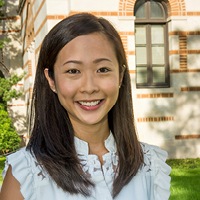 Agnes Ho, Director of Student Wellbeing
Agnes Ho, Director of Student Wellbeing
For Agnes Ho and her team at the Student Wellbeing Office, the mental health of the student population is the highest priority — especially during a global health crisis. Whether she’s hosting Zoom meetings with residential colleges to share resources about healthy coping or working one-on-one with students to strengthen their social connections, she’s always there for the Rice community.
- How is the Student Wellbeing Office staying engaged with students, on and off campus, during this time?
-
Our very first priority was to make sure that the Rice community, including students, faculty and staff, knows that the Wellbeing and Counseling Center is open — and that includes virtually. Students can call our office, which is available 24 hours a day, seven days a week, and they can talk to a counselor about their concerns.
When it became clear that COVID-19 was going to affect life at Rice, we reached out to all of the students that we have been working with to make sure they understand that they will continue to receive care from our office. If they are receiving a wellbeing advising service or have an appointment to meet with their counselors, we will work with them and assist with coordinating.
We also developed the resources page on our website, and we've been updating our social media to post some very short wellbeing videos and tips regularly. It’s important that we have a presence online and on social media so that students recognize us and consider us as a friendly resource.
We have also been working with student organizations, including the Graduate Student Association and the residential colleges, to offer some virtual meetings and webinars. A few weeks ago, we had a meeting with residents of Duncan College. We also collaborated with the Mental Health America of Greater Houston to launch a series of webinars. We talked about ways to encourage motivation and how to manage anxiety and uncertainty during this time. Until the end of the semester and even into the summer, we'll continue to offer support and trainings for the community.
- There has been a rising concern about the effect of self-isolating on mental health. What is the Wellness and Counseling center doing to help prepare the students who were going home and transitioning to this new mode of living?
-
This is a very difficult time to many of us, and particularly for students. It’s very shocking to hear the news that everyone needs to move out of the colleges and school and move back home. Some of the students cannot even go home and they have stayed on campus.
There are a lot of mixed feelings when it comes to self-isolating. Our students cannot go anywhere. They cannot see their friends. They cannot hang out in their college commons or go grab a coffee from Coffeehouse. Even though we need to follow protocols like physical distancing, it doesn't get rid of our need to connect with people.
During a lot of our meetings, no matter if it’s a one-on-one meeting or a virtual group meeting, we stress that it is essential to maintain positive mental health. We help students understand how to build connections. It is a matter of first acknowledging what we are thinking and how we feel. That is when we can start to put our thoughts and feelings into actions. If we can acknowledge that this is a very difficult time, that this is a very lonely time, and that the “new normal” is, in fact, not normal at all, then we can begin working on finding at least one thing that can make you feel better in the moment.
- What is something you have learned through this crisis?
-
Seventeen years ago, I was in college in Hong Kong when the SARS crisis was happening in Asia. Here at Rice, it was just a few years ago that we fell victim to Hurricane Harvey. The challenges of these events are something that I will always remember, and the one thing I learned the most after that is the word resiliency.
Resiliency was just as important then as it is now, while we're facing the pandemic. And it’s one of the easiest things to forget in times of crisis. All of the conversations that we have with our staff and also with our students are basically building that resiliency. We’re talking about the coping mechanisms and skills that can help strengthen our community. This is an opportunity to show our courage to be seen and heard and for our communities to be more united than ever.
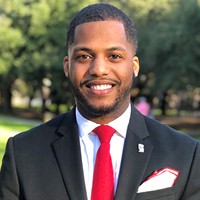 William Edmond, Residential Associate at Sid Richardson College and Assistant Director of Multicultural Affairs
William Edmond, Residential Associate at Sid Richardson College and Assistant Director of Multicultural Affairs
In both of his roles as the assistant director of multicultural affairs and residential associate of Sid Rich, William Edmond makes a point to know what Rice students are saying across the university. Now that most of the student body has departed from campus, William and the other college staffers are doing everything they can to make sure that Rice students stay engaged with university life.
- What are you, and other staff in the residential colleges, doing to support the students who are staying on campus right now?
-
Each of the “Core Teams” at the colleges — the magisters, college coordinator and resident associates — are doing as much as we can to engage virtually, and sometimes passively, with those who are still here on campus. One of our biggest challenges is to find ways to keep their spirits up. With somewhere between 15 and 20 students spread out in each college, you can probably go a long time without seeing people.
The situation is continually changing, and so we’re doing our best to change with it. We've offered meals in the commons for students to pick up at their leisure. One of our students was trying to organize a Netflix watch party. We've also created an online gaming platform through Discord where people can play video games, whether they're here on campus or away from campus, to try to have some sense of community. The most important thing is that our students know that we're always going to be a source of support.
- How are you continuing to engage with the residents who have moved back home?
-
We’ve hosted a couple of town hall meetings with the entire Sid Rich community via Zoom to keep people informed. We've also put as much new information on our website as possible so people can check it out if they’ve missed one of the Zoom meetings.
One of the most challenging things has been incorporating programming into our strategy, and the kind of programming our students are used to enjoying on campus. Time doesn’t work the same way anymore — if we plan an event after dinner, it is not necessarily the same time for everyone. What's been easier is something like a Netflix watch party. You can get everyone to watch the same thing at the same time. Some of them have created their own channels to stay in touch with smaller groups.
Often, I am asking the students to tell me what they need. Some students are taking this time to process what this transition means to them, and they’re not as engaged as they once were on campus. I've done my best to reach out to as many people as I can, whether through a phone call or by FaceTime, to get their spirits up.
I said recently to a student, "Even though you're not here, there are people who still care about you. We want you to feel like you're engaged, and if we can find an interest that mutually benefits everyone, know that we'll explore that option for you." So it has been a balance of giving them space and figuring out what will keep them excited.
- What is your highest priority right now in your role as an RA?
-
Hands down, I would say safety. We've taken significant steps at the individual residential colleges to keep our students safe, but to me, safety includes ongoing conversations of visitors coming on campus. I know the university has put stricter rules in place to try to protect people or to encourage social distancing from the students and staff who are still here every day. We need to stay focused on coming up with solutions to maintain safe spaces for our students in collaboration with community guests beyond Rice.
- What would you say has been a defining moment of the COVID-19 pandemic for you and the colleges’ “A-Teams”?
-
I would say the defining moment was maybe after week one or week two. Spring break happened, students were coming back to campus and were getting settled back into their routines — and then we heard the news that they would be leaving for the remainder of the spring semester. That's when it hit home the most.
For me, the lesson or takeaway is that college life provides an essential structure in these students’ lives. Most days follow a similar format where we all wake up, we all have access to the servery and all of the students have classes they want to attend. We're all walking to the same type of buildings on campus and going back to our favorite hangout spots. The disruption that COVID-19 has caused by everyone going to different home environments and living situations was something that no one could anticipate, and it has affected our students, faculty and staff deeply.
Some of the students now have jobs, or they're trying to provide care for family members, or they're exposed to people who may be sick or are aware of people who may be around them that are experiencing symptoms. The emotional and psychological toll that people are navigating and experiencing is hard for us to support because we can’t be in the same space as our residents. You know, we took the job wanting to interact with students, and now that engagement is different and even limiting, and has impacted us in ways we never expected. But, I've continued to be vigilant about this since they departed from campus. Hopefully, it doesn't last forever; however, it's unsettling.
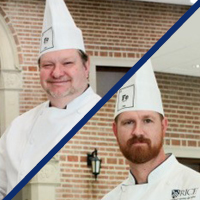 Johnny Curet, Director of Campus Dining, and Kyle Hardwick, Assistant Dining Director
Johnny Curet, Director of Campus Dining, and Kyle Hardwick, Assistant Dining Director
Throughout the COVID-19 crisis, Johnny Curet and Kyle Hardwick have been kept on their toes with making changes, sometimes daily, to the processes and protocols of the Rice dining system. What hasn’t changed is that Chefs Johnny and Kyle are dedicated to ensuring that Rice students and their own staff are well cared for.
- What were some of your team’s first steps to combat the challenges of COVID-19?
-
JOHNNY: I immediately jumped to the worst-case scenario and worked back the other way. I wouldn’t say it was easy, but it was the best possible first step to be ready for how far can we go.
We realized that it boiled down to a couple simple facts: there was food, and whoever is on campus can heat it and serve the students. Then we just kind of built it in a way that we could support the needs of campus, but with a smaller staff. We did that early. We also bought a lot of convenience foods that are individual, in case it gets to the point where we have to issue food out to students’ rooms. We have a plan for every scenario, whether the person can or can’t cook.
KYLE: Like what Johnny was saying, preparing for the changes was the immediate game plan. Johnny comes from a medical background and has previously worked with the hospitals, so some of this was already ingrained into his brain. And that’s a big benefit in this situation. We knew that as long as we had the plan in place, it would be much easier for us to execute that next step — whether we’re going from directly serving students, to a self-service concept, to completely packaging and preparing the meals because students can’t access the serveries.
- What are some of the new protocols your team is using to ensure that students stay well and safe?
-
KYLE: Earlier on, we were still opening up all the serveries, where a limited number of students could get a meal and sit within the servery. We were sensitive to the fact that the students are self-isolating, and that it can be difficult for them, but it was a little harder to manage and make sure not too many students were coming in at one time. And so we thought, “How can we change the process so we can get them in, get them out, and get them taken care of the best we can?”
JOHNNY: We made a drastic change where there are now only two serveries open, one for the North colleges and one for the South colleges. Students can no longer come inside the servery. They come to the door and tell our staff what they're looking for, and we pack it up for them. Most of these changes were based on a survey we sent out to the students, because we noticed the numbers were going down in terms of the number of people we were feeding. That was a bit concerning for us, and so it was important for us to get that feedback.
- What has the dining staff adjusted?
-
JOHNNY: While we’re doing everything we can to make sure that our students are safe, we’re making sure our staff members are safe, as well. They are coming in two or three days per week, in shifts, and that's intentional. We provide masks, multiple per day, for our staff and others on campus. We want to make sure they feel comfortable being here.
In addition, anytime we see something that may potentially be an issue, we’ll first reach out to the Rice Crisis Management team to ask for some guidance. We're constantly keeping in contact with environmental safety, as well, to make sure we’re talking about our glove usage and making sure our staff knows how to manage using the cloth masks. Our people have two each, so they always have a clean one and they have one that they can sanitize. Everyone’s safety is important to us.
KYLE: Personally, I try to check in with our staff throughout the day, and I also receive calls from staff who aren't working. We want to make sure the staff and their families have what they need and that they're doing well mentally and physically.
- What have been your team’s biggest challenges?
-
JOHNNY: One challenge has been to determine how we serve the students who are still in Houston but are not living on campus. We have about 35 students who are living off campus, and so we prepackage their meals for the whole day. They can come to campus at certain times during the day and get their three meals at one time — no matter what meal plan they have. That way they have everything they need for the next day. Their exposure is less and then they don't have to worry about how they’ll get their next meal if they’re feeling concerned about getting take-out or going to the grocery store. That's been our most important thing — making sure that if people are here, we’re going to take good care of them.
KYLE: Our next big challenge is preparing for the Texas Medical Center staff that will be housed in Wiess College and Hanszen College. We’re gearing up to see what we can do to help feed them. Neither they nor we have been through anything like this of course. The university is currently coordinating housing and we're still working with them on food.
- What are your team’s takeaways from this experience?
-
JOHNNY: Even once we’re back to “normal,” we're going to have to change the self-serve process that we've done so much, where the students help themselves to as much as they care to eat. No matter the changes, our service will still be great food and plenty to eat, but it just might have to look a bit different.
KYLE: For me, one big takeaway is that as managers we have to adapt, many times on the fly. It’s a big part of what we do sometimes on a daily basis. Let’s see what we can do with it in the future, where maybe we have more individualized kind of service points as opposed to full-scale self-serve buffets. But, in general, the staff are pretty resilient and kind of go along with us on making those changes. I think we're pretty blessed in having the staff and the crews that we do.
*At the time of this interview, two serveries were open on campus. With only around 100 students remaining after the conclusion of the spring semester, only the West Servery (between Duncan and McMurtry colleges) remains open.
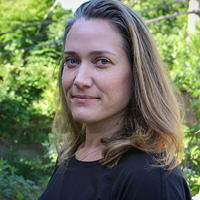 Robin Paige, Director for the Center of Teaching Excellence
Robin Paige, Director for the Center of Teaching Excellence
Typically, when Rice faculty have questions that encompass anything about teaching, the majority seek out the Faculty Fellows and staff at the Center for Teaching Excellence for guidance. So when COVID-19 forced faculty to switch gears and teach online, they naturally turned to Robin and her colleagues to ensure that students continued to receive the best education.
- What steps did the Center for Teaching Excellence (CTE) take to prepare for the possibility of moving to remote teaching?
-
We knew what was going on in China, and we saw that many universities in the States were moving their courses online. In a meeting with Brian Gibson, senior associate dean of undergraduates, and Bridget Gorman, the dean of undergraduates, I said, "Just to really be prepared, I think we're going to start putting together a teaching continuity guide for faculty in the event that we have to move some or all of the courses into a remote learning format." Even if we wouldn’t be going into a remote learning environment, I knew that we could use this in the event of hurricanes or other campus closure, flooding and other situations.
So we started working on the Teaching Continuity Guide very early on. The guide focuses on three things: keeping good communication with your students, making sure they're connected and focusing on engagement. It's really about the pedagogical questions as opposed to the practical questions of technology. We wanted our faculty to know that, first and foremost, focus on your learning goals for the course and how you can help students achieve those goals if there's a disruption and change of modality in their learning.
- What have been some of the greatest challenges Rice faculty have been facing in terms of remote teaching?
-
One of the biggest challenges for our faculty is making sure that they're putting the learning material out there and doing their assessments in a way that all students can access and complete them successfully.
The Dean of Undergraduates did a phenomenal job of making sure that students had the resources they needed when they left campus, but it is a rapidly changing context for some students. Maybe when they left Rice, their parents were employed and now they're not. Or they didn't realize how difficult it was going to be to study when they have a four-year-old brother bothering them. We have to make sure that our students get what they need from this remote learning context in the way that's most equitable.
Another question we’ve heard a lot is, “How do I make sure that I can get my students to be present and to be here?” This is a really new context for most students, and they miss being in class with their peers and with their teachers. Our faculty has to be able to really keep students engaged and to give them a new rhythm so that they can continue to be successful. And I have to give our faculty a lot of credit, because they are doing everything they can to navigate these challenges.
- What have been some of the best practices faculty have been using for remote teaching?
-
To my last point, I think our students and faculty are really feeling a sense of social isolation right now. We’re humans, and we all need that kind of connection, right? The students may have met all of their physical needs, meaning they have enough food and shelter, but if they just don't feel they can show up socially and mentally to their classes, then they can't learn.
A few faculty members come to mind who have done an exceptional job in connecting with their students. I've been working with Ray Simar, a professor of the practice in electrical and computer engineering. He put together a Zoom course where he has students doing lab work in groups and working with little circuit boards that students were able to take home.
But besides that, every Friday he's having a brown bag Zoom lunch with his students where he brings in a guest speaker or they discuss a chosen topic. One reason it works so well is because it is low stakes, and students don't have to prepare anything. They just have the opportunity to join in and have a discussion and feel connected back to him in the course.
- What would you say has been the defining moment of the COVID-19 pandemic for your team?
-
A big focus of our programming this year has been on diversity, equity and inclusion. Moving into this kind of rapid remote teaching and learning context has really laid bare a lot of the inequities that our students are dealing with and the role that classroom instruction plays in that. We have to ask, how are we going to address this moving forward? What changes must we make when we come back to residential colleges? What have we really learned about each other and our students that we can take on campus?
We need to take the perspectives of the students into consideration and bring more compassion into our teaching. I think that Rice faculty have always been dedicated to this, but this crisis has made it more obvious that we need to really focus on our students moving forward.
Because of the generosity of Rice donors, the Rice Annual Fund continues to be able to support student life and learning and gives the university the flexibility to address the most immediate needs of the COVID-19 global health event. Learn more about how your gift to the Rice Annual Fund can make an impact today at giving.rice.edu/give/rice-annual-fund.
If you would like to directly support the university’s response to COVID-19, please visit giving.rice.edu/riceresponds.
If you have questions about any of these initiatives, or are interested in discussing how you can make a philanthropic impact on undergraduate student life at Rice, please contact Sara Rice Shafer at (713) 348-5848 or sarar@rice.edu.




